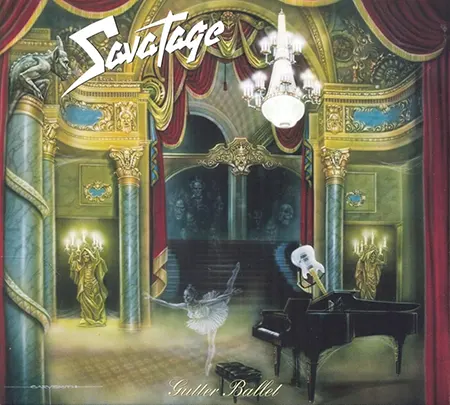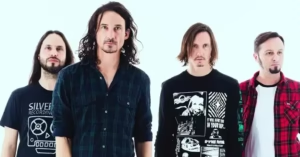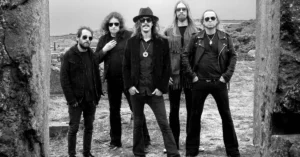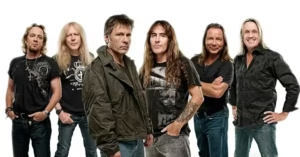Savatage: Architects of Symphonic Metal Power
Savatage. From Florida Roots to Metal Greatness
Savatage was formed in 1979 in Tarpon Springs, Florida, by brothers Jon Oliva (vocals, keyboards) and Criss Oliva (guitar). Initially called Avatar, the band had to change its name due to another act with the same moniker. The name Savatage — a portmanteau suggesting “sabotage with savage intent” — reflected their growing affinity for aggressive, dramatic metal with thematic depth.
Emerging in the early 1980s during the explosion of American heavy metal, Savatage quickly gained attention for their technical skill, theatrical flair, and the haunting combination of Jon Oliva’s dramatic vocals and Criss Oliva’s melodic yet shredding guitar work.
Savatage. Early Albums and Rise in the Metal Scene (1983–1987)
Their debut album, “Sirens” (1983), was raw, powerful, and already showcased their potential. With songs like “Holocaust” and “Rage,” it blended NWOBHM influence with American power metal energy. It was followed by “The Dungeons Are Calling” (1984), technically an EP but essential in the band’s evolution, continuing the aggressive tone with tighter production.
Their next two albums, “Power of the Night” (1985, produced by Max Norman) and “Fight for the Rock” (1986), saw mixed reception. While the former was praised for its powerful riffs and memorable tracks like “Unusual,” the latter was more commercial and widely considered a misstep, forced by label pressure.
Hall of the Mountain King and Artistic Breakthrough (1987–1990)
“Hall of the Mountain King” (1987) was the turning point — a dramatic, ambitious album that became a cult classic. Featuring standout tracks like “Hall of the Mountain King,” “Legions,” and “Strange Wings,” the album integrated classical elements, operatic vocals, and progressive structures.
This was also the beginning of Savatage’s collaboration with producer Paul O’Neill, who would become a vital creative force in the band’s career. Under O’Neill’s guidance, Savatage moved toward conceptual storytelling, theatricality, and symphonic layering.
“Gutter Ballet” (1989) was their first album to fully embrace these elements. Songs like “When the Crowds Are Gone” and “Of Rage and War” displayed a mix of piano-driven balladry, orchestration, and metal ferocity — all trademarks of their future sound.
Streets: A Rock Opera and Tragedy (1991–1993)
In 1991, Savatage released their magnum opus: “Streets: A Rock Opera”, a concept album based on a story by O’Neill about a fallen rock star named DT Jesus. With tracks like “Jesus Saves,” “Believe,” and “Ghost in the Ruins,” the album was critically acclaimed for its scope and emotion.
However, behind the scenes, tensions and exhaustion took their toll. Jon Oliva stepped down from the vocalist role due to health and personal issues, although he remained a key composer and keyboardist.
Tragedy struck in 1993 when Criss Oliva was killed in a car accident caused by a drunk driver. His death was a devastating blow to the band and the metal world. Criss’s melodic sensibility and soulful guitar work were foundational to Savatage’s identity.
New Era with Zak Stevens and Further Evolution (1993–2001)
Following Criss’s death, Savatage chose to continue, bringing in vocalist Zak Stevens, whose cleaner, more polished style marked a new chapter. Guitar duties were taken over by Alex Skolnick (ex-Testament) briefly, then Chris Caffery and Al Pitrelli solidified the lineup.
Albums from this period include:
- “Edge of Thorns” (1993): The last album with Criss Oliva. The title track remains one of their best-known songs.
- “Handful of Rain” (1994): A tribute to Criss, it mixed grief with resolve, including songs like “Chance” and “Taunting Cobras.”
- “Dead Winter Dead” (1995): A conceptual war story set during the Bosnian conflict, introducing orchestral elements and the instrumental “Christmas Eve (Sarajevo 12/24)” — a song that would take on a life of its own.
- “The Wake of Magellan” (1997): A philosophical tale of morality, justice, and the sea — another ambitious concept album with symphonic flair.
- “Poets and Madmen” (2001): Marked the return of Jon Oliva on vocals, delivering one of the band’s darkest, heaviest records.
Savatage. Birth of Trans-Siberian Orchestra
Savatage’s holiday-themed instrumental “Christmas Eve (Sarajevo 12/24)” unexpectedly became a radio hit. Realizing its potential, Paul O’Neill, Jon Oliva, and Al Pitrelli launched Trans-Siberian Orchestra (TSO) in the late 1990s — a rock opera and symphonic metal project blending Christmas themes with classical music and progressive rock.
TSO exploded in popularity in the U.S., becoming a touring juggernaut and selling millions of albums. Though a separate entity, TSO included many Savatage members and carried their spirit forward to a wider audience.
Savatage. Hiatus and Long-Awaited Reunion
After Poets and Madmen, Savatage entered a long hiatus, focusing instead on TSO. Fans waited for a reunion for years. At Wacken Open Air 2015, Savatage returned for a joint performance with TSO — an epic, dual-stage concert watched by tens of thousands, rekindling interest in a full comeback.
As of the 2020s, the band has hinted at working on new material, but no full-length release has emerged yet. However, Jon Oliva confirmed that a new Savatage album is still on the horizon.
Savatage. Musical Style and Legacy
Savatage began as a traditional heavy/power metal band but evolved into something unique: a symphonic, progressive metal hybrid long before those terms were widely used. They combined metal aggression with theatrical storytelling, classical instrumentation, and deep emotional weight.
They are widely credited as pioneers of symphonic metal, influencing bands like Symphony X, Kamelot, Nightwish, and Dream Theater. Unlike many contemporaries, Savatage embraced piano, counterpoint, and opera-style narratives, setting them apart.
Discography (Studio Albums)
- Sirens (1983)
- The Dungeons Are Calling (1984, EP)
- Power of the Night (1985)
- Fight for the Rock (1986)
- Hall of the Mountain King (1987)
- Gutter Ballet (1989)
- Streets: A Rock Opera (1991)
- Edge of Thorns (1993)
- Handful of Rain (1994)
- Dead Winter Dead (1995)
- The Wake of Magellan (1997)
- Poets and Madmen (2001)
Lineup Highlights
- Jon Oliva – Vocals, keyboards, piano, composer
- Criss Oliva – Guitar (1979–1993, †)
- Zak Stevens – Vocals (1993–2000, 2015 reunion)
- Chris Caffery – Guitar
- Al Pitrelli – Guitar
- Johnny Lee Middleton – Bass
- Steve Wacholz – Drums (early years)
- Jeff Plate – Drums (later years)
Interesting Facts
- Criss Oliva was heavily influenced by Ritchie Blackmore and Uli Jon Roth but developed a melodic style all his own.
- The “Mountain King” motif became a trademark of the band and a fan-favorite persona of Jon Oliva.
- “Chance,” from Handful of Rain, uses five-part vocal counterpoint — a technique almost never heard in metal at the time.
- Paul O’Neill, the band’s producer and lyricist, was considered the “third Oliva brother” and a visionary behind both Savatage and TSO.
- TSO’s global success brought indirect fame to Savatage songs and themes.
Final Thoughts
Savatage is a band like no other — a metal outfit with the soul of an opera, the heart of a storyteller, and the mind of a composer. Their blend of ferocious riffs, theatrical ambition, and symphonic experimentation laid the groundwork for a genre that would flourish after them. Whether through their core discography or the arena-filling majesty of Trans-Siberian Orchestra, Savatage’s influence echoes far beyond their years of activity.





